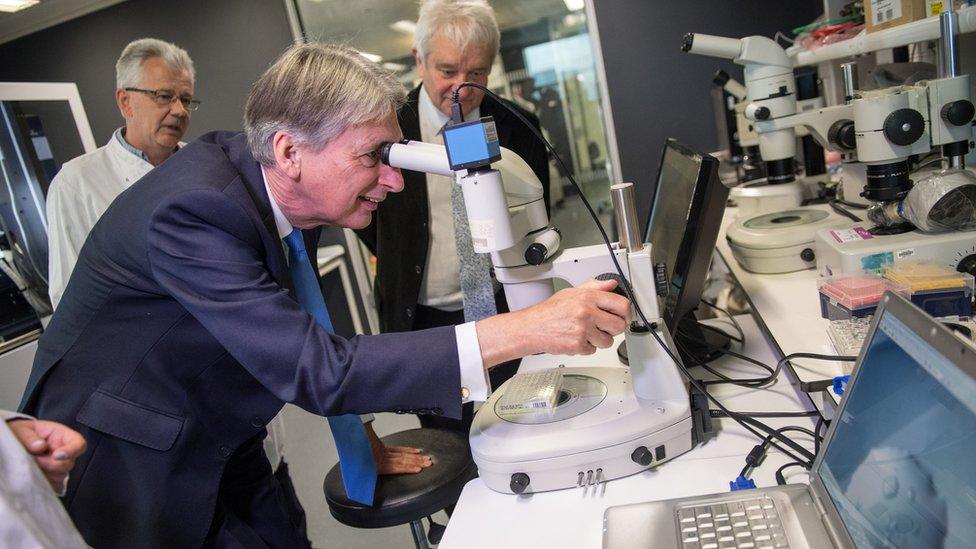Research money central to Budget
- Published

Mr Hammond was given a tour of the Crick Institute in London in October
The Chancellor Philip Hammond has made investment in research the centrepiece of his budget.
Mr Hammond said extra money for research announced last year would continue and be gradually increased.
He also said that the government's target is to increase public and private research investment from 1.68% of GDP to 2.4% of GDP by 2027.
The Chancellor added that the government was investing in artificial intelligence and driverless cars.
The president of the UK's Royal Society Venki Ramakrishnan welcomed the Chancellor's approach to investment in research.
"This budget sends a clear signal that the Government is focused on the UK's technological future, and the crucial pipeline of skills needed to ensure that we remain at the forefront of the technological revolution," he said.
"Technologies such as machine learning and AI have the potential to improve our lives in many ways, including creating jobs, and the government has also recognised that to truly take advantage of this potential there is much work to be done to ensure the benefits are shared by all."
In last year's Autumn Statement, Mr Hammond announced a substantial increase in research funding over the next four years. It would receive an extra 拢425m in 2017/18, 拢820m in 2018/19, 1.5bn in 2019/20 and 2bn in 2020/21. This would be on top of the 6.5bn government science budget.
Lesser increase?
The Chancellor announced today that the additional funding for 2021/2022 would be 拢2.3bn.
Liberal Democrat MP Norman Lamb, chair of the House of Commons Science and Technology Committee, said that the increase in funding was not as large as it might appear.
"R&D spend will actually only rise by 拢0.5bn against current commitments for 2020-21. The increase announced today will mean that a further 拢1.9bn will need to be added to the annual science budget between 2022 and 2027.
"At a time of uncertainty when the science community is looking to the government for leadership, the Chancellor's plans are a tentative move in the right direction, but much more is needed."
The expectation is that the extra money being poured into research will encourage industry to increase its funding on R&D. The government has set itself the ambitious aim of doubling the total amount of money spent by public and private organisations on research from just over 拢30bn a year to 拢46bn by 2027.
The UK currently spends 1.7% of its GDP on R&D, ranking 23rd behind Iceland and Norway. The Chancellor's latest uplift for science spending would put the government on track to play its part in raising the UK's percentage spend of GDP to 2.4%. This would raise Britain's ranking to 13th if other countries maintained their level of spending. But the UK would still be below Belgium.
Mr Hammond said the government wants to increase investment from both public and private sources
The increase was hailed as part of a new industrial strategy which would aim to harness the UK's scientific strengths to boost the economy by creating new high tech companies and jobs.
The additional money was given after a reorganisation of the current system of research funding. A new body, called the UK Research and Innovation (UKRI) agency is to be created next year to oversee the allocation of funds.
Dr Sarah Main, the director of the Campaign for Science and Engineering (Case) welcomed the additional funding but expressed concern that it might be skewed toward commercially beneficial areas of research, so called challenge funds involving industry, at the expense of fundamental and socially useful R&D.
"Such sizeable public investment brings a responsibility to spend it effectively. The new money is to be spent on modes of challenge-led funding that are relatively untested," she said.
"It will be important to establish mechanisms to ensure these funds are well spent and to grow the UK's tried and tested research funding mechanisms to meet research priorities as well as political priorities. After all, the UK needs a thriving research base to generate the stream of ideas that turn innovation into the products and services of tomorrow."
Another concern is whether industry will deliver its end of the bargain. The private sector is expected to provide two thirds of the overall funding to reach the new GDP target.
Mr Hammond announced that he would continue to review reforms that would allow more long-term funding from the financial sector rather than the two to five year return usually demanded by investors.
To reach their target of R&D investment across the economy of 2.4% of GDP, "the government must attract private investment of over 拢8bn", said Dr Main.
"To continue to invest here, research-intensive companies are clear that the UK must provide a competitive economy with a healthy research base and immigration and regulation systems that support international R&D."
The Chancellor also announced 拢9m for a new body to "enable ethical innovation in AI and data".
Follow Pallab